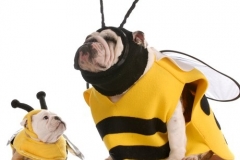Emergency Vet Clinic in Brampton, Highway 10
Halloween & Pets
 Halloween and Christmas share more in common than the Nightmare Before Christmas and competition for department store displays in the autumn, they are also the source of a significant spike in pet poisoning cases yearly.
Halloween and Christmas share more in common than the Nightmare Before Christmas and competition for department store displays in the autumn, they are also the source of a significant spike in pet poisoning cases yearly.
The Pet Poison Helpline notes that their call centre’s veterinarians receive a 12% jump in phone contacts yearly, with Ahna Brutlag, DVM, MS, the assistant director of the organisation reporting, “Each year we experience a sharp increase in calls around Halloween, especially during the weekends surrounding the holiday.”
The chief cause of the poisonings can be attributed directly to the readily available sweets that are now as synonymous with Halloween as ghosts and ghouls.
Chocolate is a very poisonous substance for pets, dogs in particular. Just how poisonous an ingestion of chocolate can be for a dog can be determined by how much of the substance’s caffeine and theobromine have been consumed, the two ingredients of chocolate that are toxic to pets. The darker the chocolate is, the more harmful it is, but a larger portion of milk chocolate can produce the same outcome.
Symptoms of Chocolate Poisoning
- Vomiting
- Diarrhea
- Increased Thirst
- Elevated Heart Rate
- Lethargy
- Agitation
- Seizures
Review this Dog Chocolate Toxicity Meter for a better understanding of the different types of chocolate and portion levels.
Raisins can be extremely poisonous to both dogs and cats. Many pet owners do not suspect that grapes, and thereby raisins, can do so much harm when they are distributed to eager trick-or-treaters as the healthy alternative, but sometimes even a few of them can cause acute kidney or organ damage so severe that they prove fatal.
Symptoms of Grape/Raisin Poisoning
- Nausea
- Decreased Appetite
- Vomiting
- Lethargy
- Abdominal Pain
- Severe Kidney Failure
While not all dogs feel the effects as strongly, this is a case in which it is better to be safe than sorry, best keep the grapes and raisins shut away from pet access.
Eating too much candy isn’t just a problem for the most prolific trick-or-treating children. Given the opportunity, many dogs with gorge themselves on sweets as well. Aside from the impacts of chocolate and raisin poisoning, an ingestion of a very large quantity of sugary candy with high-fat contents can in worst cases lead to a fatal onset of pancreatitis.
Symptoms of Eating Too Much Candy
- Decreased Appetite
- Vomiting
- Diarrhea
- Lethargy
- Abdominal Pain
- Severe Kidney Failure
- Organ Damage
Unfortunately, if your dog has eaten a large amount of candy but they seem to be handling it, pancreatitis may not set in for several days. With stakes this high, it’s more proof that the candy should be locked away.
Candy Wrappers can even cause humans grief from time to time when sticky sweets resist the peeling of their protective wrapping. When it comes to our dogs, however, they don’t generally bother with that cumbersome process and eat the candy whole. Another danger comes from the discarded candy wrappers that have been jettisoned about the house. Items like these can cause a number of digestive issues for pets.
Symptoms of Consuming Candy Wrappers
- Vomiting
- Decreased Appetite
- Straining Bowel Movements
- Not Defecating
- Lethargy
With the evidence of the crime consumed, it can be difficult to ascertain if a dog has eaten a candy wrapper. For this reason, x-rays are often required when the above symptoms are displayed.
With so many dangers sitting in a bowl by our front doors and in our cupboards waiting for Halloween, it’s a wonder that the spike in calls to the Pet Poison Helpline isn’t higher than 21% each year at the end of October. Take due diligence to protect your pet and always keep your emergency veterinarian’s number handy, it could save your pet’s life.